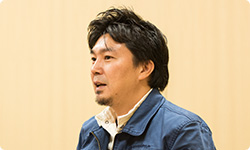Ooiwa-san, when did you first hear about the New Nintendo 3DS system?
We were already in the second half of the development stage. We finished the porting processes in general and were starting to incorporate the new challenging elements one by one. That’s why we usually had our meetings at the GREZZO office in Tokyo around that time, but one day out of the blue, you had asked us, “How about having a meeting in Kyoto for a change?”
Now that’s a suspicious invitation! (laughs)
It was! (laughs) However, at the time, we thought, “It isn’t bad to have meetings in Kyoto once in a while.” So we decided to take up the offer.
At the time, you probably thought “Yes, we get to visit Kyoto for the first time in a long time!”, all the while being oblivious to the workload that awaited you. (laughs)
That’s right! (laughs) After we got there, we were shown the New Nintendo 3DS.
The system wasn’t announced yet, so we asked you to come all the way to Kyoto.
And when they arrived, I immediately requested to add a feature to spin the camera with the C Stick18 in-game.18. C Stick: An analogue stick newly added on the above and to the left of the A, B, X and Y Buttons on the right side of New Nintendo 3DS systems.
I was surprised that you asked for such a request at that timing! (laughs)
Sorry about that, but I really wanted to move the camera around in this game. We integrated the free-to-control camera for the first time in The Legend of Zelda: The Wind Waker19, and from that experience I knew how well it felt when I was able to use that.19. The Legend of Zelda: The Wind Waker: An action adventure game released in May 2003 in Europe for the Nintendo GameCube console.
So, after that I brought back a large task given by Aonuma-san. However, at the time, the New Nintendo 3DS system was still confidential, so we couldn’t talk about it to most of our staff. We had to gather up a limited number of people, such as the programmers in charge, and work on this task in a hush-hush manner.

“Hush-hush”, huh! (laughs)
But thanks to integrating this feature, players can now see the icon of this game, the moon , while they move Link around.
And you couldn’t do that in the Nintendo 64 version. You have an idea that the moon is falling lower, but you couldn’t really see it.
You expect the moon to look bigger on the third day, but you can’t really see it. But now, you can enjoy gazing at the moon whenever you want! (laughs)
It’s really nice, isn’t it? (laughs)
But wasn’t it hard to add the camera rotation feature after you’d reached near the end of the development process?
It was. After all, Majora’s Mask has many types of programming that determines the camera controls.
So it’s a system where there are many different types of camera programs depending on the scene?
That’s right. There are various types of camera programs that adjust to match different scenes like climbing ladders and flying as Deku Link. Even compared to Ocarina of Time, there are quite a number of them.
This is why we had to experiment on an enormous scale of how we could combine the many camera programs with the camera controls of the C Stick.
Above that, we needed to consider Link’s transformations. The default Link and Goron Link are different heights, so the height of the cameras are different, too.
And by being able to moving the camera around freely, you’re now able to see stuff that you weren’t supposed to see…
So those are the problems you faced when integrating the C Stick.
Right. Unexpected problems appeared here and there, so it wasn’t an easy task.
I see. I think I learned another reason why developing this game took such a long time! (laughs)
But we gained a tremendous result for pulling through, didn’t we?
Definitely.
By being able to move the camera with the C Stick, we were able to clearly show that Majora’s Mask was reborn.
So although it was a hard task, the efforts paid off, and it was able to contribute greatly to the appeal of the game.
I believe so.
By the way, the New Nintendo 3DS has a super-stable 3D feature20, but how well does that match up with Majora’s Mask 3D?20. Super-stable 3D: One of the new features of New Nintendo 3DS systems. A camera automatically tracks and adjusts to where the user’s face is, so the 3D will look stable even if they move around.
Well, when you play a Zelda game, you can’t really sit still.
It’s true that you naturally start moving your body while you play a fun action game.
So for the Nintendo 3DS systems, the 3D effects looked blurry when I played with it. However, when I heard about the face-tracking 3D feature being integrated into the New Nintendo 3DS systems, I was really excited about this feature. When I was playing Ocarina of Time 3D, the 3D effects did get a little blurry occasionally, however this never happened when I played with the New Nintendo 3DS system, so I was able to play without stress, even with the 3D effects on.
When you replay games that have already released with the New Nintendo 3DS system, doesn’t it feel like you’re playing a whole different game?
It does.
When I first received a New Nintendo 3DS system, I first replayed Luigi’s Mansion 2 for Nintendo 3DS21, and thought, “Oh, this is a completely different game,” and I felt that the appeal of other games that utilised 3D like Kid Icarus: Uprising22, Ocarina of Time 3D, Mario Kart 723, and Super Mario 3D Land24 improved drastically. It looked so good that it made me want to apologise for not having the 3D functions work this well when we first released the Nintendo 3DS system. Of course, such technology was not available when we released the original Nintendo 3DS, so it was impossible to integrate it at the time. I hope people will forget their expectations of 3D from the past, and replay the Nintendo 3DS games they played before on New Nintendo 3DS.21. Luigi’s Mansion 2 for Nintendo 3DS: An action adventure game released in March 2013 in Europe for Nintendo 3DS systems.22. Kid Icarus: Uprising: An action shooting game released for Nintendo 3DS systems in March 2012 in Europe.23. Mario Kart 7: An action racing game released for Nintendo 3DS systems in December 2011 in Europe.24. Super Mario 3D Land: A 3D action game released for Nintendo 3DS systems in November 2011 in Europe.
Yes, I agree that there is that much of a difference. Reeling the topic back to Majora’s Mask 3D, I have to admit that it probably took so long to develop this game partially because we were waiting for the New Nintendo 3DS systems to arrive! (laughs)
Oh, so that’s how you’ll explain why it took so long! (laughs) So you’re saying that because you were waiting for the New Nintendo 3DS, you took some time in developing this game?
Well, it really doesn't get blurry when you spin the camera, and it really opened up the tight-spaced feeling players might have felt from the world of Majora’s Mask. Because we spent so much time working on this game, we were able to have this pleasant encounter.
Was there anything that improved with the stereoscopic view?
Basically, the world of Majora’s Mask has a very complex design. From the buildings in the town to the dungeons, the stereoscopic views make it easier to detect your directions forward and backward, as well as above and below, so I believe it contributed to help players figure out where they need to go.

For example, when Deku Link flies, the stereoscopic view makes it easier to detect the location of where to land. So being able to view things stereoscopically has positively contributed to this game in many ways.
The gyro sensor25 controls are really good, too. Come to think of it, wasn’t Aonuma-san playing the minigame, Clock Town’s Famous Archery Game, in a recently uploaded video?25. Gyro sensor: A sensor included in Nintendo 3DS, Nintendo 2DS and New Nintendo 3DS systems which tracks the angle and the rotation speed of the system.
Ohhhh, that’s right. Termina Quest26, right? (laughs)26. Eiji Aonuma’s Termina Quest: A gameplay walkthrough video posted on the Japanese official website for Majora’s Mask 3D and the Japanese Nintendo official YouTube channel. The videos show Eiji Aonuma attempting minigames that are in Majora’s Mask 3D.
It only took you three tries to get a perfect score. I shouted “yes!” when you accomplished that! (laughs)
To be honest, I was surprised myself. I was never able to get a perfect score in the Nintendo 64 version.
Did the gyro controls work well with this game?
I believe so. The motion control for the Nintendo 3DS is very stable. Plus, the wonderful timing adjustments made by the developers of GREZZO most likely contributed to me getting a perfect score on the third try.
We did make quite an amount of adjustments for the archery game. So, when I shouted “yes!”, that was also because I knew our adjustments worked! (laughs)
© 2024 Nintendo.